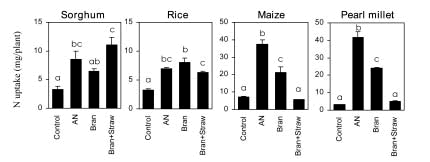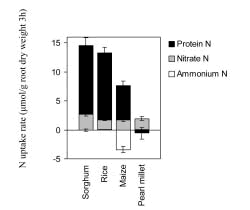Interspecific difference in the utilization of proteinaceous nitrogen among gramineous crops
Description
[Objectives]
In the developing regions such as Sub-Saharan Africa, farmers use litter chemical fertilizers and instead utilize organic materials such as crop residues and manure as alternate sources of nitrogen (N). When organic N is applied to soil, the amount of proteinaceous N, the most common form of available N in soil, temporarily increases. In order to develop the integrated use of organic and inorganic materials, it is necessary to understand the mechanisms behind the utilization of differing forms of N by crop species. Thus, the properties of proteinaceous N utilization by four globally important gramineous crops-sorghum, upland rice, maize and pearl millet-were elucidated in this study.
[Results]
As a field experiment, equal amounts of N (150 kg N/ha) were applied in both inorganic (urea) and organic (a mixture of rice bran and rice straw, C/N=20) forms, and its effects on the growth of the four gramineous crops were monitored. The four crops were divided into two groups in terms of their response to organic N application. Sorghum and upland rice displayed more prominent growth under organic N treatment than under inorganic N treatment, whereas maize and pearl millet did not show significant difference in growth under the two treatments. A similar pattern was also observed in the N uptake of these crop species. Sensitivity towards organic N in upland rice had previously been revealed, but that of sorghum was newly discovered through this experiment.
In pot experiments, the same amount of N (500 mg N/kg) was applied in the form of (1) ammonium nitrate, (2) rice bran (C/N=12), and (3) a mixture of rice bran and rice straw (C/N=20). N uptake of each of the four crops was compared 21 days after transplanting. The four crops were again divided into the same two groups. Sorghum and upland rice absorbed similar quantities of N from both organic and inorganic N treatments, while maize and pearl millet absorbed more N from inorganic N treatment than from organic N treatment (Fig. 1). These results reflected the proteinaceous N and inorganic N content in the soils under each treatment.
Uptake rates of proteinaceous N were directly measured from a solution culture system. Proteinaceous N, extracted from field soil treated with a neutral phosphate buffer and purified through dialysis, was added to the solution; decreases in levels of proteinaceous N in the solution was used as a means of measuring N uptake by the plant roots. Absorption rates of proteinaceous N was much higher in sorghum and upland rice than in maize, and no proteinaceous N was absorbed by pearl millet roots (Fig. 2). These results suggest that the above-mentioned responses to organic N application among crops are due differing absorption rates of proteinaceous N from the soil.
Figure, table
-
Fig. 1.
N uptake by the four gramineous crops under differing N treatments (pot experiment).
Differing letters indicate significant differences (p < 0.05). (AN: ammonium nitrate) -
Fig. 2.
Nitrogen uptake rates of the four crop species when N was applied to the root bathing solution in the form of proteinaceous N. Vertical lines indicate standard deviations.
- Affiliation
-
Japan International Research Center for Agricultural Sciences Crop Production and Environment Division
- Classification
-
Technical A
- Term of research
-
FY2003 (FY2001-2003)
- Responsible researcher
-
OKADA Kensuke ( Crop Production and Environment Division )
OKAMOTO Miwa ( University of Tokyo )
- ほか
- Publication, etc.
-
Okamoto, M., Okada, K., Watanabe, T. and Ae, N. (2003): Growth responses of cereal crops to organic nitrogen application in the field. Soil Science and Plant Nutrition, 49, 445-452.
Okamoto, M. and Okada, K. (2004): Differential responses of growth and nitrogen uptake to organic nitrogen in four gramineous crops. J. Exp. Bot. 55, 1577-1585.
- Japanese PDF
-
2003_13_A3_ja.pdf2.6 MB
- English PDF
-
2003_13_A4_en.pdf54.45 KB


